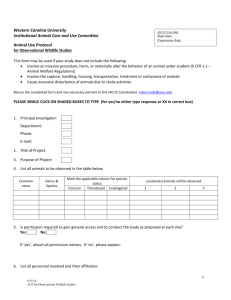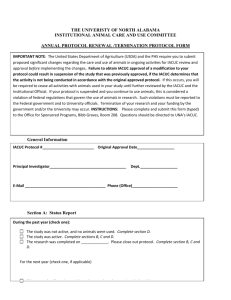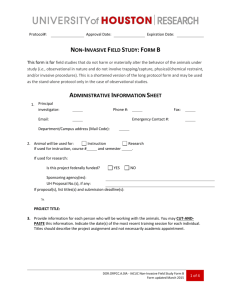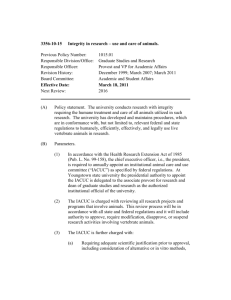Lake Superior State University Institutional Animal Care and Use
advertisement
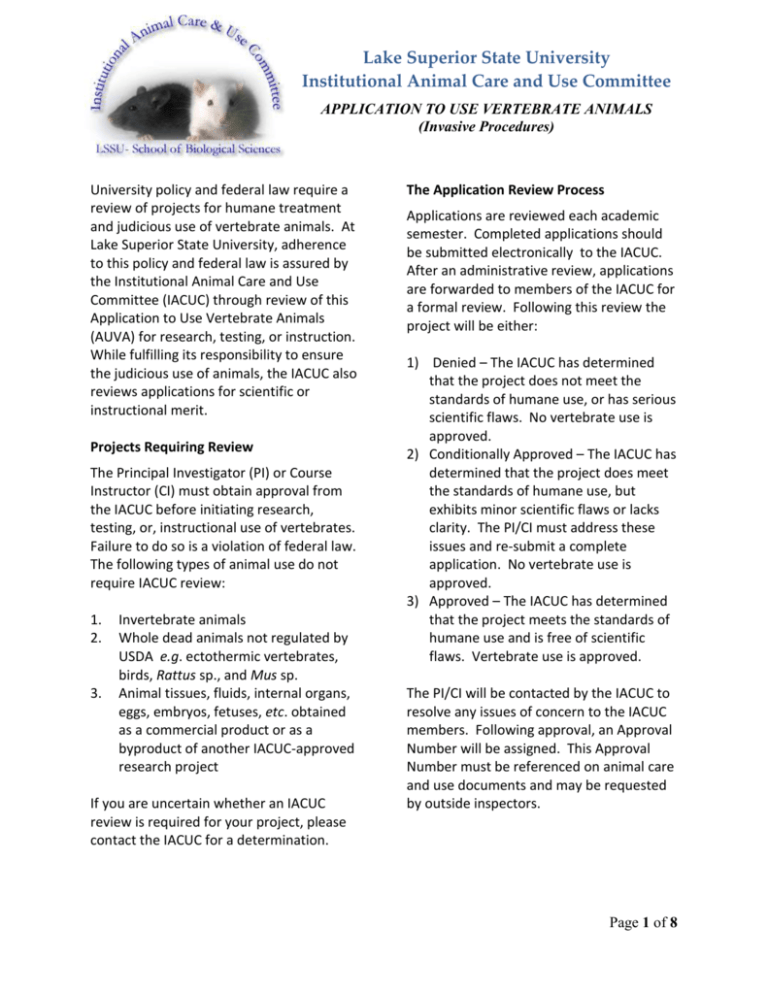
Lake Superior State University Institutional Animal Care and Use Committee APPLICATION TO USE VERTEBRATE ANIMALS (Invasive Procedures) University policy and federal law require a review of projects for humane treatment and judicious use of vertebrate animals. At Lake Superior State University, adherence to this policy and federal law is assured by the Institutional Animal Care and Use Committee (IACUC) through review of this Application to Use Vertebrate Animals (AUVA) for research, testing, or instruction. While fulfilling its responsibility to ensure the judicious use of animals, the IACUC also reviews applications for scientific or instructional merit. Projects Requiring Review The Principal Investigator (PI) or Course Instructor (CI) must obtain approval from the IACUC before initiating research, testing, or, instructional use of vertebrates. Failure to do so is a violation of federal law. The following types of animal use do not require IACUC review: 1. 2. 3. Invertebrate animals Whole dead animals not regulated by USDA e.g. ectothermic vertebrates, birds, Rattus sp., and Mus sp. Animal tissues, fluids, internal organs, eggs, embryos, fetuses, etc. obtained as a commercial product or as a byproduct of another IACUC-approved research project If you are uncertain whether an IACUC review is required for your project, please contact the IACUC for a determination. The Application Review Process Applications are reviewed each academic semester. Completed applications should be submitted electronically to the IACUC. After an administrative review, applications are forwarded to members of the IACUC for a formal review. Following this review the project will be either: 1) Denied – The IACUC has determined that the project does not meet the standards of humane use, or has serious scientific flaws. No vertebrate use is approved. 2) Conditionally Approved – The IACUC has determined that the project does meet the standards of humane use, but exhibits minor scientific flaws or lacks clarity. The PI/CI must address these issues and re-submit a complete application. No vertebrate use is approved. 3) Approved – The IACUC has determined that the project meets the standards of humane use and is free of scientific flaws. Vertebrate use is approved. The PI/CI will be contacted by the IACUC to resolve any issues of concern to the IACUC members. Following approval, an Approval Number will be assigned. This Approval Number must be referenced on animal care and use documents and may be requested by outside inspectors. Page 1 of 8 Application for the Use of Vertebrate Animals Approval Period and Annual Review IACUC approval is valid for a maximum of three years for faculty research projects or instructional activities. For multi-year projects, the PI/CI will be sent a brief Annual Review Form. Completion of this form is required for compliance with the regulations of the Federal Animal Welfare Act. Failure to return the Annual Review Form is a violation of federal law and will lead to inactivation of IACUC approval to use animals. The approval period for undergraduate research projects is limited to one year (undergraduate projects are eligible for renewal). Modifying Approved Applications Prior to making significant changes in animal research activities, investigators must receive approval of the proposed changes from the IACUC. These changes should be described in a written narrative. The name of the PI/CI, current Approval Number, and title of the project must be referenced in the narrative. The PI/CI should be sure to describe all aspects in which the change may alter their approved protocol. This is best accomplished by reviewing the currently approved application, and addressing each question affected. A modification to an approved application undergoes the same review process as do new or renewal applications. Investigators should allow 2-3 weeks for review of modifications by the IACUC. General Instructions The application should be completed and submitted electronically. Complete the application in its entirety. Abbreviations Non-Invasive Procedures must be clearly spelled out and/or defined upon first use. Applicants may find that they will be asked to provide brief answers regarding issues which they have discussed in detail in another part of the form. Please answer each question as stated and do not simply refer to another answer elsewhere in the application. Michigan Freedom of Information Act Applicants should be aware that approved applications may be obtained through the Michigan FOIA. Applications should be written in a manner which will allow them to sustain public scrutiny. Avoid unnecessary use of inflammatory descriptive language. For example, when discussing euthanasia, use the word "euthanize" and avoid the use of the words "sacrifice" and "kill". Where practical, include sufficient detail and explanations to address anticipated questions and concerns from the general public. Unacceptable Applications Reasons why applications may not be for review include, but are not limited to: Incomplete applications Use of an obsolete form The PI/CI is not affiliated with LSSU Use of technical language that a nonscientist might not understand in Questions 3 and 4 Inadequate description of animal use procedures in Question 11 A single composite answer to questions with multiple subparts Missing signatures Page 2 of 8 Non-Invasive Procedures Application for the Use of Vertebrate Animals For IACUC Use Only Date Received ____________ Approved Approval Date ____________ Approval Period _________ Approval # ________ New Application Revised Application Renewal Application Conditional Denied Conditional Approval Date Click here to enter a date. Approval # Click here to enter #. Save the completed application as a Word file (<name>_AUVA.docx) and email to the IACUC chair. Principal Investigator (PI) or Course Instructor (CI) Click here to enter name. Telephone Click here to enter #. Faculty Student E-mail Click here to enter address. Faculty Mentor Click here to enter name. Project Title /Course Click here to enter text. List all personnel who will perform procedures involving animals. Name Phone Click to enter Click to enter Click to enter Click to enter Click to enter Click to enter Click to enter Click to enter Click to enter Click to enter Click to enter Click to enter Click to enter Click to enter Click to enter Click to enter Click to enter Click to enter Click to enter Click to enter Click to enter Duties Page 3 of 8 Non-Invasive Procedures Application for the Use of Vertebrate Animals 1. What species of animal are you requesting to use? (Please provide scientific names) Click here to enter list. 2. What type of animal use is proposed in this application? Basic Research Field Research Other Specify 3. Applied Research Instruction or Training How would you explain to a non-scientist, the objective(s) of the proposed work? Click here to enter text. 4. How would you explain to a non-scientist, how the proposed animal use will advance our knowledge? Click here to enter text. 5. Check all planned experimental or instructional procedures* that will be performed on the animals requested in this application. All procedures checked below must be explained in Question 9. Capture Confinement Restraint Food/water manipulation Noxious stimulus Other environmental manipulation Other Specify *If invasive procedures are planned you must complete the Invasive Procedures Application. 6. Indicate how you have monitored scientific advances that would enable you to use less painful or distressful procedures. Review of scientific journals Attendance at scientific meetings Discussion with colleagues Click here to enter text. Page 4 of 8 Non-Invasive Procedures Application for the Use of Vertebrate Animals 7. In the event that it becomes necessary to euthanize animals during this project, what method will be used? Click here to enter text. a. AVMA classification of euthanasia methods Acceptable (Go to 7c) Conditional Unacceptable b. Justification for selecting a method of euthanasia classified as conditionally acceptable or unacceptable. Click here to enter text. c. How will you ensure that animals will not revive (e.g. removal of heart, induction of bilateral pneumothorax, observation of rigor mortis)? Click here to enter text. d. What will happen to animals the die or are euthanized during or at the conclusion of thie project? Click here to enter text. e. What will happen to animals that do not die or are not euthanized during this project? Click here to enter text. 8. 9. What drugs will be used for euthanasia? ( None go to 9) a. Drug(s) to be used Click here to enter text. b. Dose (mg/kg) Click here to enter text. c. Route of administration Click here to enter text. Describe all planned procedures involving animals (e.g. capture, handling, restraint, habitat manipulations etc.). Include time frames and intervals and describe procedures in the order in which they will be performed. All procedures checked in Question 5 should be described below. Page 5 of 8 Non-Invasive Procedures Application for the Use of Vertebrate Animals Click here to enter text. 10. Describe expected adverse consequences that the animals may experience as a result of the procedures described in Question 9. Examples of adverse consequences include discomfort, pain, or stress. Click here to enter text. 11. If animals are to be captured, estimate the total number of animals of each species to be captured. Explain how you calculated the required number of animals. If applicable, indicate the number of animals in experimental and control groups. Click here to enter text. 12. Why must animals be used to accomplish the proposed work? Click here to enter text. 13. Why was the requested species of animals chosen for the proposed work? Describe the biological characteristics of the animal essential to the proposed study. Click here to enter text. 14. Identify the source of the animals to be used in this project. Click here to enter text. 15. Will animals be restrained for more than 30 minutes? a. Yes No (go to 16) List the type(s) of restraint devices to be used. Click here to enter text. b. Specify the maximum duration and frequency of restraint. Click here to enter text. c. Briefly describe the purpose of the physical restraint. Click here to enter text. 16. List any non-target species that are likely to be captured during this project. Page 6 of 8 Application for the Use of Vertebrate Animals Non-Invasive Procedures Click here to enter text. 17. Describe the procedures for handling non-target captures. Click here to enter text. Page 7 of 8 Application for the Use of Vertebrate Animals Non-Invasive Procedures PRINCIPAL INVESTIGATOR'S ASSURANCE I acknowledge responsibility for this project. I am familiar with LSSUs policies for the care and use of laboratory animals and certify that this project will be conducted in compliance with those principles. I have obtained any and all required state or federal permits. (Attach copies of permits) I assure that I will obtain IACUC approval prior to significant changes in the protocol. I assure that all personnel on the project are qualified or will be trained to conduct the project in a humane and scientific manner. _____________________________________________ Signature of Principal Investigator/Course Instructor _________________ Date Page 8 of 8

